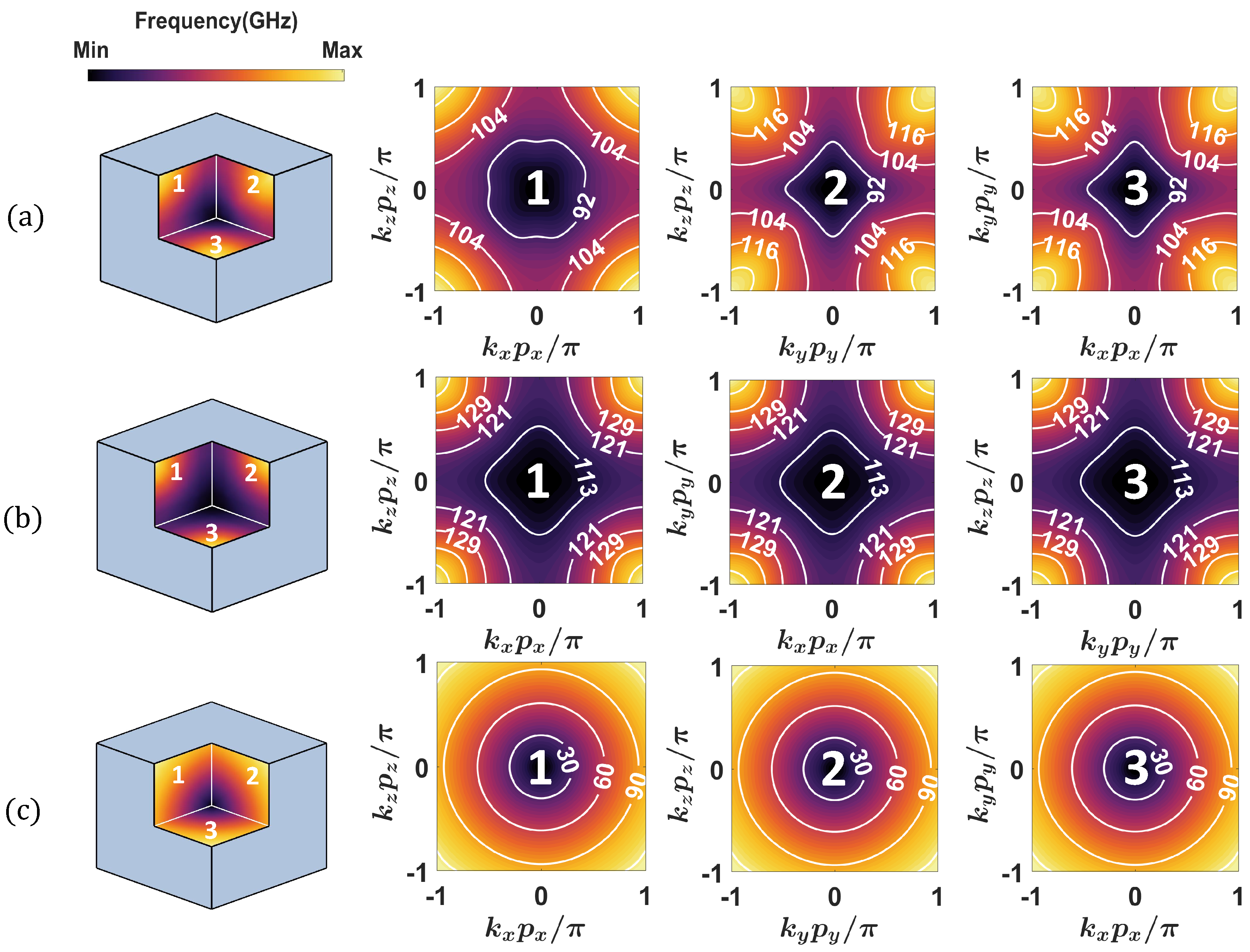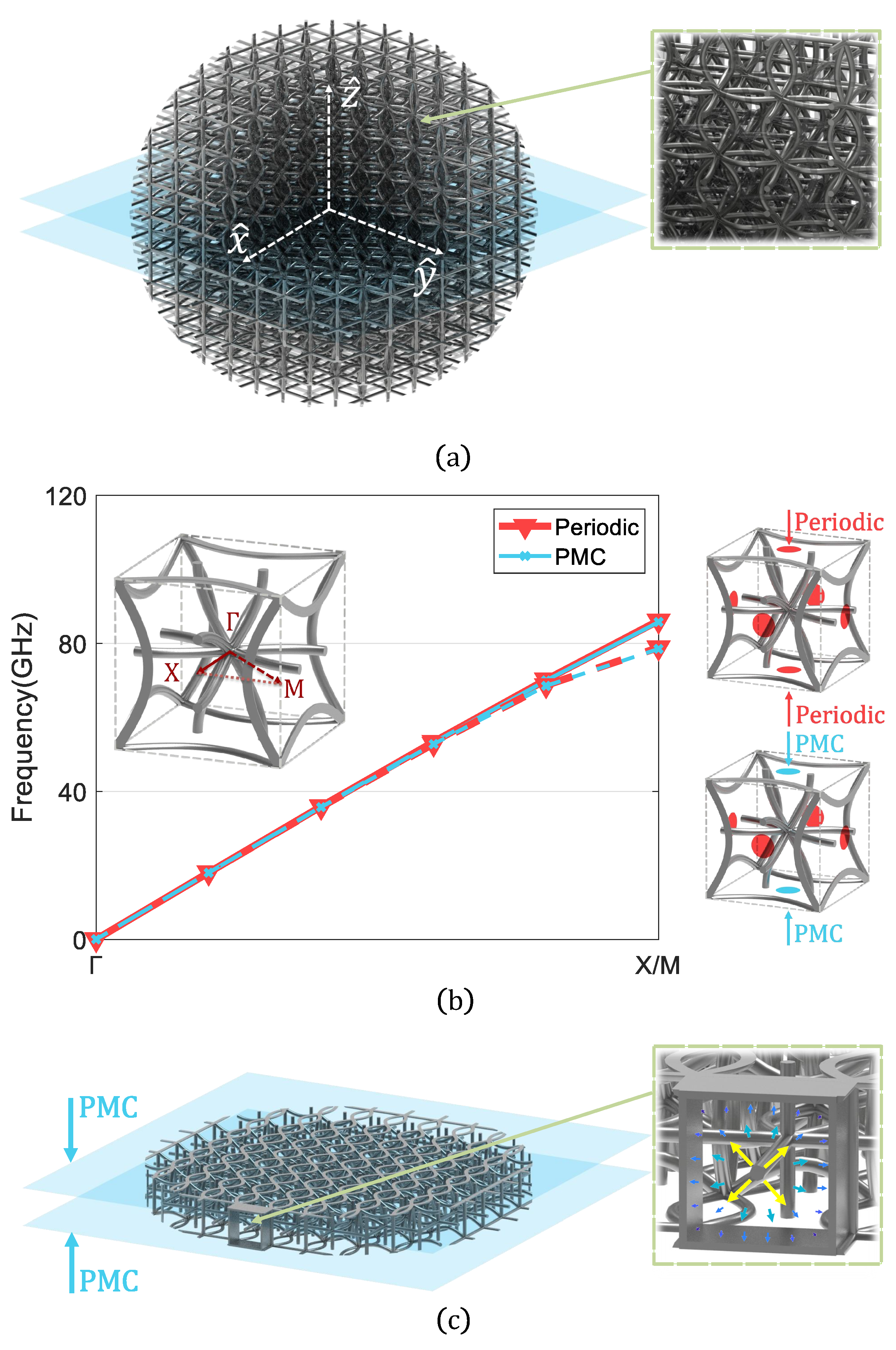Three-Dimensional Broadband and Isotropic Double-Mesh Twin-Wire Media for Meta-Lenses
Abstract
:1. Introduction
2. Dispersion Analysis of the Double-Mesh Twin-Wire Structure
3. Design of Luneburg Lens
4. Conclusions
Author Contributions
Funding
Data Availability Statement
Acknowledgments
Conflicts of Interest
References
- Schoenlinner, B.; Wu, X.; Ebling, J.; Eleftheriades, G.; Rebeiz, G. Wide-scan spherical-lens antennas for automotive radars. IEEE Trans. Microw. Theory Tech. 2002, 50, 2166–2175. [Google Scholar] [CrossRef]
- Wang, Y.; Li, J.; Huang, L.; Jing, Y.; Georgakopoulos, A.; Demestichas, P. 5G Mobile: Spectrum Broadening to Higher-Frequency Bands to Support High Data Rates. IEEE Veh. Technol. Mag. 2014, 9, 39–46. [Google Scholar] [CrossRef]
- Sipus, Z.; Komljenovic, T. Multi-shell Radially Symmetrical Lens Antennas. In Aperture Antennas for Millimeter and Sub-Millimeter Wave Applications; Boriskin, A., Sauleau, R., Eds.; Springer International Publishing: Cham, Switzerland, 2018; pp. 37–73. [Google Scholar]
- Quevedo-Teruel, O.; Ebrahimpouri, M.; Ghasemifard, F. Lens Antennas for 5G Communications Systems. IEEE Commun. Mag. 2018, 56, 36–41. [Google Scholar] [CrossRef]
- Quevedo-Teruel, O.; Liao, Q.; Chen, Q.; Castillo-Tapia, P.; Mesa, F.; Zhao, K.; Fonseca, N.J. Geodesic lens antennas for 5G and beyond. IEEE Commun. Mag. 2021, in press. [Google Scholar]
- Hua, C.; Wu, X.; Yang, N.; Wu, W. Millimeter-wave homogenous cylindrical lens antenna for multiple fan-beam scanning. J. Electromagn. Waves Appl. 2012, 26, 1922–1929. [Google Scholar] [CrossRef]
- Peeler, G.; Coleman, H. Microwave stepped-index luneberg lenses. IRE Trans. Antennas Propag. 1958, 6, 202–207. [Google Scholar] [CrossRef]
- Thornton, J. Wide-scanning multi-layer hemisphere lens antenna for Ka band. IEE Proc. Microwaves Antennas Propag. 2006, 153, 573–578. [Google Scholar] [CrossRef]
- Liang, M.; Ng, W.R.; Chang, K.; Gbele, K.; Gehm, M.E.; Xin, H. A 3-D Luneburg Lens Antenna Fabricated by Polymer Jetting Rapid Prototyping. IEEE Trans. Antennas Propag. 2014, 62, 1799–1807. [Google Scholar] [CrossRef]
- Budhu, J.; Rahmat-Samii, Y.; Hodges, R.E.; Hofmann, D.C.; Ruffatto, D.F.; Carpenter, K.C. Three-Dimensionally Printed, Shaped, Engineered Material Inhomogeneous Lens Antennas for Next-Generation Spaceborne Weather Radar Systems. IEEE Antennas Wirel. Propag. Lett. 2018, 17, 2080–2084. [Google Scholar] [CrossRef]
- Zhao, Y.Y.; Zhang, Y.L.; Zheng, M.L.; Dong, X.Z.; Duan, X.M.; Zhao, Z.S. Three-dimensional Luneburg lens at optical frequencies. Laser Photonics Rev. 2016, 10, 665–672. [Google Scholar] [CrossRef]
- Bjorkqvist, O.; Zetterstrom, O.; Quevedo-Teruel, O. Additive manufactured dielectric Gutman lens. Electron. Lett. 2019, 55, 1318–1320. [Google Scholar] [CrossRef]
- Wang, C.; Wu, J.; Guo, Y.X. A 3-D-Printed Multibeam Dual Circularly Polarized Luneburg Lens Antenna Based on Quasi-Icosahedron Models for Ka-Band Wireless Applications. IEEE Trans. Antennas Propag. 2020, 68, 5807–5815. [Google Scholar] [CrossRef]
- Lou, Y.H.; Zhu, Y.X.; Fan, G.F.; Lei, W.; Lu, W.Z.; Wang, X.C. Design of Ku-Band Flat Luneburg Lens Using Ceramic 3-D Printing. IEEE Antennas Wirel. Propag. Lett. 2021, 20, 234–238. [Google Scholar] [CrossRef]
- Ansari, M.; Jones, B.; Zhu, H.; Shariati, N.; Guo, Y.J. A Highly Efficient Spherical Luneburg Lens for Low Microwave Frequencies Realized with a Metal-based Artificial Medium. IEEE Trans. Antennas Propag. 2020, 69, 3758–3770. [Google Scholar] [CrossRef]
- Xue, L.; Fusco, V.F. 24 GHz automotive radar planar Luneburg lens. IET Microwaves Antennas Propag. 2007, 1, 624–628. [Google Scholar] [CrossRef]
- Liu, P.; Zhu, X.; Zhang, Y.; Jiang, Z.H.; Wang, X.; Hong, W.; Le, T.H. A Novel E-plane-Focused Cylindrical Luneburg Lens Loaded With Metal Grids for Sidelobe Level Reduction. IEEE Trans. Antennas Propag. 2020, 68, 736–744. [Google Scholar] [CrossRef]
- Xue, L.; Fusco, V.F. Printed holey plate Luneburg lens. Microw. Opt. Technol. Lett. 2008, 50, 378–380. [Google Scholar] [CrossRef]
- Pfeiffer, C.; Grbic, A. A Printed, Broadband Luneburg Lens Antenna. IEEE Trans. Antennas Propag. 2010, 58, 3055–3059. [Google Scholar] [CrossRef]
- Quevedo-Teruel, O.; Miao, J.; Mattsson, M.; Algaba-Brazalez, A.; Johansson, M.; Manholm, L. Glide-Symmetric Fully Metallic Luneburg Lens for 5G Communications at Ka-Band. IEEE Antennas Wirel. Propag. Lett. 2018, 17, 1588–1592. [Google Scholar] [CrossRef]
- Bantavis, P.; Gonzalez, C.G.; Sauleau, R.; Goussetis, G.; Tubau, S.; Legay, H. Broadband graded index Gutman lens with a wide field of view utilizing artificial dielectrics: A design methodology. Opt. Express 2020, 28, 14648–14661. [Google Scholar] [CrossRef]
- Fan, F.; Cai, M.; Zhang, J.; Yan, Z.; Wu, J. Wideband Low-Profile Luneburg Lens Based on a Glide-Symmetric Metasurface. IEEE Access 2020, 8, 85698–85705. [Google Scholar] [CrossRef]
- Zetterstrom, O.; Hamarneh, R.; Quevedo-Teruel, O. Experimental Validation of a Metasurface Luneburg Lens Antenna Implemented With Glide-Symmetric Substrate-Integrated Holes. IEEE Antennas Wirel. Propag. Lett. 2021, 20, 698–702. [Google Scholar] [CrossRef]
- Kunz, K. Propagation of microwaves between a parallel pair of doubly curved conducting surfaces. J. Appl. Phys. 1954, 25, 642–653. [Google Scholar] [CrossRef]
- Liao, Q.; Fonseca, N.; Quevedo-Teruel, O. Compact multibeam fully metallic geodesic Luneburg lens antenna based on non-Euclidean transformation optics. IEEE Trans. Antennas Propag. 2018, 66, 7383–7388. [Google Scholar] [CrossRef]
- Fonseca, N.J.G.; Liao, Q.; Quevedo-Teruel, O. Equivalent Planar Lens Ray-Tracing Model to Design Modulated Geodesic Lenses using Non-Euclidian Transformation Optics. IEEE Trans. Antennas Propag. 2020, 68, 3410–3422. [Google Scholar] [CrossRef]
- Seol, S.K.; Kim, D.; Lee, S.; Kim, J.H.; Chang, W.S.; Kim, J.T. Electrodeposition-based 3D Printing of Metallic Microarchitectures with Controlled Internal Structures. Small 2015, 11, 3896–3902. [Google Scholar] [CrossRef]
- Das, S.; Bourell, D.L.; Babu, S.S. Metallic materials for 3D printing. MRS Bull. 2016, 41, 729–741. [Google Scholar] [CrossRef] [Green Version]
- Chieh, J.C.S.; Dick, B.; Loui, S.; Rockway, J.D. Development of a Ku-Band Corrugated Conical Horn Using 3-D Print Technology. IEEE Antennas Wirel. Propag. Lett. 2014, 13, 201–204. [Google Scholar] [CrossRef]
- Rebollo, A.; Vaquero, A.F.; Arrebola, M.; Pino, M.R. 3D-Printed Dual-Reflector Antenna With Self-Supported Dielectric Subreflector. IEEE Access 2020, 8, 209091–209100. [Google Scholar] [CrossRef]
- Dimitriadis, A.I.; Debogović, T.; Favre, M.; Billod, M.; Barloggio, L.; Ansermet, J.P.; de Rijk, E. Polymer-Based Additive Manufacturing of High-Performance Waveguide and Antenna Components. Proc. IEEE 2017, 105, 668–676. [Google Scholar] [CrossRef]
- Silveirinha, M.; Fernandes, C. Homogenization of 3-D-connected and nonconnected wire metamaterials. IEEE Trans. Microw. Theory Tech. 2005, 53, 1418–1430. [Google Scholar] [CrossRef]
- Shin, J.; Shen, J.T.; Fan, S. Three-dimensional electromagnetic metamaterials that homogenize to uniform non-Maxwellian media. Phys. Rev. B 2007, 76, 113101. [Google Scholar] [CrossRef] [Green Version]
- Chen, W.J.; Hou, B.; Zhang, Z.Q.; Pendry, J.B.; Chan, C.T. Metamaterials with index ellipsoids at arbitrary k-points. Nat. Commun. 2018, 9, 1–10. [Google Scholar] [CrossRef]
- Quevedo-Teruel, O.; Ebrahimpouri, M.; Kehn, M.N.M. Ultrawideband Metasurface Lenses Based on Off-Shifted Opposite Layers. IEEE Antennas Wirel. Propag. Lett. 2016, 15, 484–487. [Google Scholar] [CrossRef]
- Arnberg, P.; Barreira Petersson, O.; Zetterstrom, O.; Ghasemifard, F.; Quevedo-Teruel, O. High Refractive Index Electromagnetic Devices in Printed Technology Based on Glide-Symmetric Periodic Structures. Appl. Sci. 2020, 10, 3216. [Google Scholar] [CrossRef]
- Quevedo-Teruel, O.; Chen, Q.; Mesa, F.; Fonseca, N.J.; Valerio, G. On the Benefits of Glide Symmetries for Microwave Devices. IEEE J. Microwaves 2021, 1, 457–469. [Google Scholar] [CrossRef]
- Crepeau, P.J.; McIsaac, P.R. Consequences of symmetry in periodic structures. Proc. IEEE 1964, 52, 33–43. [Google Scholar] [CrossRef] [Green Version]
- Mittra, R.; Laxpati, S. Propagation in a wave guide with Glide refection symmetry. Can. J. Phys. 1965, 43, 353–372. [Google Scholar] [CrossRef]
- Kieburtz, R.; Impagliazzo, J. Multimode propagation on radiating traveling-wave structures with glide-symmetric excitation. IEEE Trans. Antennas Propag. 1970, 18, 3–7. [Google Scholar] [CrossRef]
- Hessel, A.; Chen, M.H.; Li, R.C.M.; Oliner, A.A. Propagation in periodically loaded waveguides with higher symmetries. Proc. IEEE 1973, 61, 183–195. [Google Scholar] [CrossRef]
- Dahlberg, O.; Ghasemifard, F.; Valerio, G.; Quevedo-Teruel, O. Propagation characteristics of periodic structures possessing twist and polar glide symmetries. Eur. Phys. J. Appl. Metamater. 2019. [Google Scholar] [CrossRef] [Green Version]
- Castillo-Tapia, P.; Van Gassen, K.; Chen, Q.; Mesa, F.; Sipus, Z.; Quevedo-Teruel, O. Dispersion Analysis of Twist-Symmetric Dielectric Waveguides. Photonics 2021, 8, 206. [Google Scholar] [CrossRef]
- Chen, Q.; Giusti, F.; Valerio, G.; Mesa, F.; Quevedo-Teruel, O. Anisotropic glide-symmetric substrate-integrated-holey metasurface for a compressed ultrawideband Luneburg lens. Appl. Phys. Lett. 2021, 118, 084102. [Google Scholar] [CrossRef]
- Poyanco, J.M.; Zetterstrom, O.; Castillo-Tapia, P.; Fonseca, N.J.G.; Pizarro, F.; Quevedo-Teruel, O. Two-dimensional glide-symmetric dielectric structures for planar graded-index lens antennas. IEEE Antennas Wirel. Propag. Lett. 2021. [Google Scholar] [CrossRef]
- Luneburg, R. Mathematical Theory of Optics; Brown University Press: Providence, RI, USA, 1944; pp. 208–213. [Google Scholar]






Publisher’s Note: MDPI stays neutral with regard to jurisdictional claims in published maps and institutional affiliations. |
© 2021 by the authors. Licensee MDPI, Basel, Switzerland. This article is an open access article distributed under the terms and conditions of the Creative Commons Attribution (CC BY) license (https://creativecommons.org/licenses/by/4.0/).
Share and Cite
Wang, H.; Chen, Q.; Zetterstrom, O.; Quevedo-Teruel, O. Three-Dimensional Broadband and Isotropic Double-Mesh Twin-Wire Media for Meta-Lenses. Appl. Sci. 2021, 11, 7153. https://doi.org/10.3390/app11157153
Wang H, Chen Q, Zetterstrom O, Quevedo-Teruel O. Three-Dimensional Broadband and Isotropic Double-Mesh Twin-Wire Media for Meta-Lenses. Applied Sciences. 2021; 11(15):7153. https://doi.org/10.3390/app11157153
Chicago/Turabian StyleWang, Hairu, Qiao Chen, Oskar Zetterstrom, and Oscar Quevedo-Teruel. 2021. "Three-Dimensional Broadband and Isotropic Double-Mesh Twin-Wire Media for Meta-Lenses" Applied Sciences 11, no. 15: 7153. https://doi.org/10.3390/app11157153
APA StyleWang, H., Chen, Q., Zetterstrom, O., & Quevedo-Teruel, O. (2021). Three-Dimensional Broadband and Isotropic Double-Mesh Twin-Wire Media for Meta-Lenses. Applied Sciences, 11(15), 7153. https://doi.org/10.3390/app11157153






